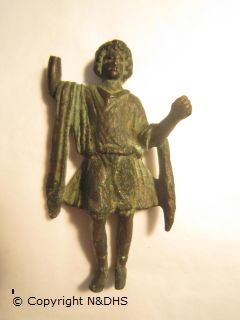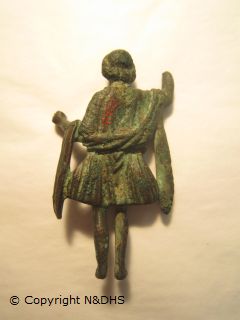Roman Finds in Navan
Roman Statue

This statue, at approx 8 cm high, and made of copper alloy, is described as having originally been ‘found in the River Boyne near to Navan’. It is Roman and was believed to be a representation of Hercules, but now thought by the museum to perhaps be a representation of a Lar (Lares were important deities for households in the Roman Empire[i]). This raises the question; were Romans in Navan? If so, did they make a votive offering to the River Boyne, as was their custom, or was this item simply dropped accidentally by someone crossing the river, who maybe had traded with Romans in Romano Britain, in Europe, or in an Irish port? Possibly the figure was simply lost at a much later date, but it is not the only Roman item found in the Navan district.
Roman Coins
Other Roman items found in Navan include 2 coins. The first is described as being ‘of Faustina’[ii]. It was deposited in the Royal Irish Academy by Mr. Petrie, who was given it for this purpose by Mr. W. F. Wakeman[iii]. The publication of The Journal of the Proceedings of the Academy for 1850-53 does record that ‘It was a rather curious circumstance that Roman coins should be so frequently discovered in that particular locality[iv].’ This raises the possibility that more coins may have been found but never recorded or deposited for safe-keeping. The second coin recorded is ‘of Constantine’ and was found near Navan in 1848[v]. This coin is recorded in the National Museum. Again, we can only wonder whether Romans themselves left these coins or whether they came to Ireland through trade with Romano Britain, or further afield. Other Roman artefacts have been found in the greater area such as those found at Telltown[vi] . It is regrettable that the exact locations of the statue and these two coin finds have not been faithfully recorded, rather than simply being noted as having been found ‘near Navan‘.
Interestingly, both the coin named as being “of Faustina” and the statue were originally ‘found’, or at least described as such, and then presented for recording and safe keeping, by a person to whom Navan owes much of what has been preserved of its heritage to, Mr. Frederick William Wakeman (1822 – 1900).
[i] http://www.museum.ie/en/list/documentationdiscoveries.aspx?article=1c9dc3df-a916-4711-abe1-f69e9ca0d4ef
[ii] Address to the Earl of Eglinton, Lord Lieutenant of Ireland, &c. Earl of Eglinton Lord Lieutenant of Ireland
Proceedings of the Royal Irish Academy, (1836-1869), Vol. 5, (1850 - 1853), p 271.
[iii] Ibid.
[iv] Ibid.
[v] Index of The National Museum of Ireland.
[vi] Talk given by Kells and District Tourism Forum Lecture Series hosts a talk entitled 'Archaeological Investigations at the ‘royal’ enclosure of Ráith Airthir, Teltown' by Dr. Ger Dowling, on Sunday 28 April 2013 in Donaghpatrick Hall.